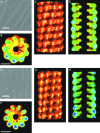Structure of flexible filamentous plant viruses
- PMID: 18667514
- PMCID: PMC2546986
- DOI: 10.1128/JVI.00895-08
Structure of flexible filamentous plant viruses
Abstract
Flexible filamentous viruses make up a large fraction of the known plant viruses, but in comparison with those of other viruses, very little is known about their structures. We have used fiber diffraction, cryo-electron microscopy, and scanning transmission electron microscopy to determine the symmetry of a potyvirus, soybean mosaic virus; to confirm the symmetry of a potexvirus, potato virus X; and to determine the low-resolution structures of both viruses. We conclude that these viruses and, by implication, most or all flexible filamentous plant viruses share a common coat protein fold and helical symmetry, with slightly less than 9 subunits per helical turn.
Figures







Similar articles
-
A common structure for the potexviruses.Virology. 2013 Feb 5;436(1):173-8. doi: 10.1016/j.virol.2012.11.008. Epub 2012 Dec 11. Virology. 2013. PMID: 23245732
-
Atomic structure of potato virus X, the prototype of the Alphaflexiviridae family.Nat Chem Biol. 2020 May;16(5):564-569. doi: 10.1038/s41589-020-0502-4. Epub 2020 Mar 16. Nat Chem Biol. 2020. PMID: 32203412
-
Potyvirus virion structure shows conserved protein fold and RNA binding site in ssRNA viruses.Sci Adv. 2017 Sep 20;3(9):eaao2182. doi: 10.1126/sciadv.aao2182. eCollection 2017 Sep. Sci Adv. 2017. PMID: 28948231 Free PMC article.
-
[Investigation of helical plant virus ribonucleoprotein structures with the help of tritium planigraphy and theoretical modeling].Mol Biol (Mosk). 2004 Sep-Oct;38(5):945-58. Mol Biol (Mosk). 2004. PMID: 15554196 Review. Russian.
-
Helical viruses.Adv Exp Med Biol. 2012;726:631-58. doi: 10.1007/978-1-4614-0980-9_28. Adv Exp Med Biol. 2012. PMID: 22297534 Review.
Cited by
-
The Phylogeography of Potato Virus X Shows the Fingerprints of Its Human Vector.Viruses. 2021 Apr 9;13(4):644. doi: 10.3390/v13040644. Viruses. 2021. PMID: 33918611 Free PMC article.
-
Plug-and-Display Photo-Switchable Systems on Plant Virus Nanoparticles.BioTech (Basel). 2022 Oct 21;11(4):49. doi: 10.3390/biotech11040049. BioTech (Basel). 2022. PMID: 36278561 Free PMC article.
-
Applications of viral nanoparticles in medicine.Curr Opin Biotechnol. 2011 Dec;22(6):901-8. doi: 10.1016/j.copbio.2011.04.020. Epub 2011 May 16. Curr Opin Biotechnol. 2011. PMID: 21592772 Free PMC article. Review.
-
Structural basis for the multitasking nature of the potato virus Y coat protein.Sci Adv. 2019 Jul 17;5(7):eaaw3808. doi: 10.1126/sciadv.aaw3808. eCollection 2019 Jul. Sci Adv. 2019. PMID: 31328164 Free PMC article.
-
Top 10 plant viruses in molecular plant pathology.Mol Plant Pathol. 2011 Dec;12(9):938-54. doi: 10.1111/j.1364-3703.2011.00752.x. Epub 2011 Oct 21. Mol Plant Pathol. 2011. PMID: 22017770 Free PMC article. Review.
References
-
- Abramoff, M. D., P. J. Magelhaes, and S. J. Ram. 2004. Image processing with ImageJ. Biophotonics Int. 1136-42.
-
- Adams, M. J., J. F. Antoniw, M. Bar-Joseph, A. A. Brunt, T. Candresse, G. D. Foster, G. P. Martelli, R. G. Milne, S. K. Zavriev, and C. M. Fauquet. 2004. The new plant virus family Flexiviridae and assessment of molecular criteria for species demarcation. Arch. Virol. 1491045-1060. - PubMed
-
- Adams, M. J., J. F. Antoniw, and C. M. Fauquet. 2005. Molecular criteria for genus and species discrimination within the family Potyviridae. Arch. Virol. 150459-479. - PubMed
-
- Atreya, C. D., B. Raccah, and T. P. Pirone. 1990. A point mutation in the coat protein abolishes aphid transmissibility of a potyvirus. Virology 178161-165. - PubMed
Publication types
MeSH terms
Substances
Grants and funding
LinkOut - more resources
Full Text Sources
Other Literature Sources

